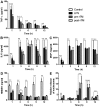Evaluation of the effect of recombinant thrombomodulin on a lipopolysaccharide-induced murine sepsis model
- PMID: 28587368
- PMCID: PMC5450552
- DOI: 10.3892/etm.2017.4308
Evaluation of the effect of recombinant thrombomodulin on a lipopolysaccharide-induced murine sepsis model
Abstract
To evaluate the effect of recombinant human thrombomodulin (rTM) on sepsis, the levels of nucleosome as well as high-mobility group box 1 (HMGB1) and cytokines in sera and peritoneal fluids were measured in a mouse model of lipopolysaccharide (LPS)-induced sepsis after administration of rTM. C57BL/6 mice were intraperitoneally injected with LPS (15 mg/kg; Escherichia coli O111:B4) with or without the intravenous administration of rTM (3 mg/kg; 30 min prior to or 2 h after LPS injection). The survival rates were evaluated and levels of tumor necrosis factor (TNF)-α, interleukin (IL)-6, monocyte chemoattractant protein (MCP)-1, HMGB1 and nucleosome in sera and peritoneal fluids were analyzed by ELISA. Administration of rTM prior to or after LPS improved the survival rate of septic mice. In addition, rTM administered prior to or after LPS suppressed the level of pro-inflammatory cytokine TNF-α in sera at 1-3 h after LPS injection, whereas only the administration of rTM after LPS suppressed the levels of HMGB1 and nucleosome (late-phase mediators of sepsis) (9-12 h) in sera after the LPS injection. Furthermore, administration of rTM prior to or after LPS suppressed the level of TNF-α in the peritoneal fluids at 1-3 h after LPS injection, whereas only the administration of rTM after LPS suppressed the levels of IL-6 and MCP-1 in the peritoneal fluids at 6-9 h after LPS injection. These observations indicated that administration of rTM significantly improves the survival rate and suppresses the increased levels of TNF-α, IL-6, MCP-1, HMGB1 and nucleosome in the LPS-induced septic shock model. Thus, rTM may exert a protective action on sepsis and reduce mortality, possibly by reducing not only the levels of cytokines and chemokine but also the levels of late-phase mediators of sepsis.
Keywords: cytokines; high-mobility group box 1; lipopolysaccharide; neutrophil extracellular traps; nucleosome; recombinant thrombomodulin; sepsis.
Figures



Similar articles
-
Thrombomodulin as a Physiological Modulator of Intravascular Injury.Front Immunol. 2020 Sep 16;11:575890. doi: 10.3389/fimmu.2020.575890. eCollection 2020. Front Immunol. 2020. PMID: 33042158 Free PMC article. Review.
-
Effects of Thrombomodulin in Reducing Lethality and Suppressing Neutrophil Extracellular Trap Formation in the Lungs and Liver in a Lipopolysaccharide-Induced Murine Septic Shock Model.Int J Mol Sci. 2021 May 6;22(9):4933. doi: 10.3390/ijms22094933. Int J Mol Sci. 2021. PMID: 34066510 Free PMC article.
-
Recombinant thrombomodulin attenuates hyper-inflammation and glycocalyx damage in a murine model of Streptococcus pneumoniae-induced sepsis.Cytokine. 2022 Jan;149:155723. doi: 10.1016/j.cyto.2021.155723. Epub 2021 Oct 15. Cytokine. 2022. PMID: 34662822
-
Therapeutic potential of recombinant thrombomodulin for lung injury after pneumonectomy via inhibition of high-mobility group box 1 in mice.J Trauma Acute Care Surg. 2016 Nov;81(5):868-875. doi: 10.1097/TA.0000000000001208. J Trauma Acute Care Surg. 2016. PMID: 27504958
-
In vivo and in vitro effects of the anticoagulant, thrombomodulin, on the inflammatory response in rodent models.Shock. 2010 Mar;33(3):282-8. doi: 10.1097/SHK.0b013e3181b0ef7b. Shock. 2010. PMID: 19536047
Cited by
-
A two-decade journey in identifying high mobility group box 1 (HMGB1) and procathepsin L (pCTS-L) as potential therapeutic targets for sepsis.Expert Opin Ther Targets. 2023 Jul-Dec;27(7):575-591. doi: 10.1080/14728222.2023.2239495. Epub 2023 Jul 25. Expert Opin Ther Targets. 2023. PMID: 37477229 Free PMC article. Review.
-
Thrombomodulin: A key regulator of intravascular blood coagulation, fibrinolysis, and inflammation, and a treatment for disseminated intravascular coagulation.Proc Jpn Acad Ser B Phys Biol Sci. 2025 Feb 10;101(2):75-97. doi: 10.2183/pjab.101.006. Epub 2024 Dec 18. Proc Jpn Acad Ser B Phys Biol Sci. 2025. PMID: 39694492 Free PMC article. Review.
-
Endogenous Regulation and Pharmacological Modulation of Sepsis-Induced HMGB1 Release and Action: An Updated Review.Cells. 2021 Aug 27;10(9):2220. doi: 10.3390/cells10092220. Cells. 2021. PMID: 34571869 Free PMC article. Review.
-
Time to Develop Therapeutic Antibodies Against Harmless Proteins Colluding with Sepsis Mediators?Immunotargets Ther. 2020 Oct 5;9:157-166. doi: 10.2147/ITT.S262605. eCollection 2020. Immunotargets Ther. 2020. PMID: 33117741 Free PMC article. Review.
-
Thrombomodulin as a Physiological Modulator of Intravascular Injury.Front Immunol. 2020 Sep 16;11:575890. doi: 10.3389/fimmu.2020.575890. eCollection 2020. Front Immunol. 2020. PMID: 33042158 Free PMC article. Review.
References
LinkOut - more resources
Full Text Sources
Other Literature Sources
Miscellaneous
